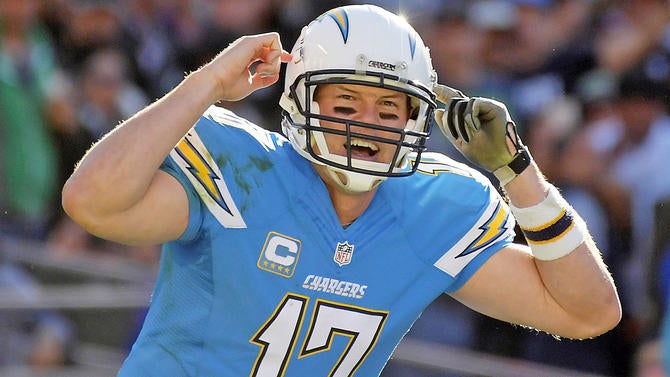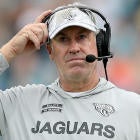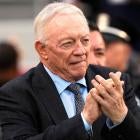When the Rams and Chargers announced late last week that the $2.6 billion stadium they are set to construct in Inglewood, still in its relative infancy, would already be at least a year delayed in its opening, I couldn't help but conjure images of f-bombs being yelled and coffee mugs being hurled across the room in the teams' corporate offices.
I mean, that's how I probably would've reacted if I had Kroenke or Spanos for a last name.
And the idea that this isn't really much of an issue, and that such a significant delay could be caused by El Niño and a rainy winter in Southern California gave me some pause as well. Turns out I'm not the only one. There are some very impactful, very real, financial losses associated with this postponement for both clubs, to say nothing of the marketing and branding hit both will absorb having to remain in makeshift temporary homes for at least three more seasons. There are also very real concerns about running well over that original $2.6 billion projection given the inauspicious start to the project, and the consequences are far more telling than some might want you to believe.
Los Angeles has long been a fickle mistress for the NFL, and having to send this message to these two fledgling fan bases, at least in their current locations, is suboptimal at best. It puts the ability to host the 2021 Super Bowl in jeopardy, and while Rams owner Stan Kroenke still stands to vastly increase his already massive wealth over time with the construction of this football Taj Mahal, in the short term there will be fiscal pain for these two franchises to the tune of $150 million each in lost revenue for each year beyond 2019 lost due to construction delays, some suggest.
As I digested the news over the weekend, my thoughts quickly turned to former Eagles president Joe Banner, the point man in the construction of Lincoln Financial Field in downtown Philadelphia in 2003. Banner is anything but a shrinking violet, and I imagined what his reaction might have been had some construction manager called him 16 months after being granted NFL approval for his stadium, with nothing but a huge hole still in the ground, and informed him the stadium was going to be at least a year delayed from opening.
"I'd like to think I wouldn't have let it get to that point," Banner said matter-of-factly. Fair enough. OK. But let's say hypothetically that there had been an extra snowy winter in Philly and he got this news that The Linc was going to open a year later. On a scale of 1-10, how freaked out would he be?

"Oh, I'm freaking out," Banner said. "I'm definitely freaking out until I meet with people like the construction manager and the architects to really get a handle on what's going on. I'd want to know, right away, did somebody mislead me to the point that I put out 2019 and now it's already 2020? Are the architects way behind? Is the construction manager under-staffing the project?
"I'm reading these guys the riot act, and I may even be looking at replacing my construction manager already if that's the source of it. That's who you are hiring to really oversee everything … and they'd have some really serious questions to answer from me. And if they can't answer them, then I'd have to replace them now. The really shocking thing is for this to happen now. It would be one thing where it came to this point two years in and you lose a year; even that shouldn't happen, but it can happen. When it happens now, and you haven't really done anything yet, that's troubling."
For starters, the idea that the weather caused this prolonged of a delay, well, executives and sports business experts simply aren't buying it. This is outside whatever realm of expertise I have -- assuming I even have one -- but it's fair to say there were collective eye rolls from the folks I spoke to about El Niño being the primary culprit here. And they all agreed that to have something this big come down already likely portends costs overruns and possibly other delays as well.
One former NFL executive who was involved in the construction of a state-of-the-art stadium this decade noted how facilities in places like Cleveland and Minnesota and Chicago, with far more severe weather, got built on time.

"Playing four years in antiquated stadiums costs $100s of millions," he noted. He estimated that each team could lose $50 million per year in gate, $50 million in sponsorships, $40 million in suites and maybe $10 million in concessions/parking per year the stadium is behind. "It's hard to believe they couldn't have figured this out knowing how much was at stake."
Furthermore, each team will have to play an international game for an additional season while they are in a temporary home, and the Rams might delay their unveiling of new uniforms for a year (they are tying it to the new stadium), which could hurt with their merchandising in the meantime.
"The loss of that year is over $100 million in actual costs versus what they would have been had they opened on time. That's just the math of it," Banner said. He noted that in actuality, the project likely might be only three or four months behind, but given how short the NFL regular season is in relation to the entire year, that's enough to push you back a full season. "To be this far behind when you've barely really started the project, I've never heard of it."
The Rams and Chargers both took this calculated gamble focused on the long view, of course, buying into the concept that with the right facility and glitz and gloss (and winning product on the field), both teams will enjoy riches and revenue streams far beyond anything ever conceivable had they stayed in St. Louis or San Diego. And I would agree that, say, 15 years from now they might be right. I would also point out there is a reason L.A. went over two decades without a team to call its own after the Rams and Raiders fled, and nothing is guaranteed in the NFL -- though owners making a lot of money is generally a very safe proposition.
There is a unified public front between the two teams, who strove to put their new fan bases at ease with the statements they released last week on the matter. The Rams said, "This new target gives us flexibility to accommodate any additional delays that may arise while still delivering an unparalleled experience upon opening." A.G. Spanos, the Chargers' president of business operations, said in the statement: "If getting it right means pushing back the completion date, then I think the extra year is well worth it. Construction is our family business, so we understand the challenges that come with a project of this magnitude."
The Chargers, who will be playing in 27,000-seat StubHub Center -- a soccer-specific stadium -- face more acute potential losses of revenue, and there is increased pressure on these rebuilding teams to start winning immediately, or close to it, to keep the buy-in from fans coming. Marty Conway, a professor of sports and business at Georgetown and a former executive with the Baltimore Orioles, Texas Rangers and Major League Baseball who was with franchises as they built new stadiums, pointed to the difficulties the Falcons had selling PSLs for their new stadium three years out before they made their Super Bowl run in 2016.
In Conway's estimation, selling "hope" for two years while getting a facility built is feasible, but pushing that out another year puts more onus to win now to keep fans engaged during construction. Appeasing the corporate community in Los Angeles shouldn't be as tricky. "I think the corporate money, sponsorships, suites, etc. will be less at risk, due to major sponsorships being in 3-5 year [and beyond] cycles," Conway said. "Those relationships take time to source and sign, and unless there is some major dislocation to the financial markets, companies are more comfortable committing, and then waiting it out."
It remains to be seen if the NFL's zeal to run out and thrust two teams into the L.A. market was the wisest decision, and there are no shortage of execs who are holding their breath regarding the forthcoming Raiders move to Las Vegas (including among some owners who went ahead and voted for it). This isn't just about three markets. The overall health of the league and its total revenue pie, given the sharing model, is exposed to some risk.
Conway maintains that some of that zest is tied into the NFL's ongoing global initiatives, given that sustaining recent domestic growth will be difficult at best. Los Angeles might be a bridge to further westward markets, and getting it right in L.A. will have lingering ramifications. Having the Rams and Chargers stuck in substandard homes for another full year is hardly a deal-breaker, but it is a more meaningful turn of events than some might have you believe.
"As hard as the NFL, led by Jerry Jones and others, are trying to recover the L.A. market, the winds always seem to be in their face," Conway noted. "This project is the foundation to an 'NFL West' presence, which, I believe, they hope to even try to reach into Asia from there. Not only the teams, but a future Super Bowl, TV and media hub, development, retail, merchandise, you name it. They are not betting one, but two franchises, on this project and process …
"Between the harm to the Chargers, the issue about the 2021 Super Bowl still being 'committed' to L.A. and the prospect of even more 'challenges/delays' along the way, this is a much bigger issue than the 'spin' coming from the NFL, L.A. and the developers."

















